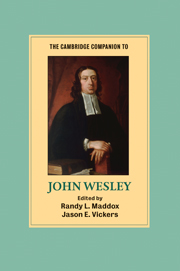Book contents
- Frontmatter
- Introduction
- Part I Wesley’s context
- Part II Wesley’s life
- Part III Wesley’s work
- 4 Wesley as revivalist/renewal leader
- 5 Wesley as preacher
- 6 Wesley as biblical interpreter
- 7 John Wesley as diarist and correspondent
- 8 John Wesley as editor and publisher
- 9 Wesley’s engagement with the natural sciences
- 10 Wesley as adviser on health and healing
- 11 Wesley’s theological emphases
- 12 Happiness, holiness, and the moral life in John Wesley
- 13 Wesley’s emphases on worship and the means of grace
- Part IV Wesley’s legacy
- Select bibliography
- Index
13 - Wesley’s emphases on worship and the means of grace
from Part III - Wesley’s work
Published online by Cambridge University Press: 28 September 2010
- Frontmatter
- Introduction
- Part I Wesley’s context
- Part II Wesley’s life
- Part III Wesley’s work
- 4 Wesley as revivalist/renewal leader
- 5 Wesley as preacher
- 6 Wesley as biblical interpreter
- 7 John Wesley as diarist and correspondent
- 8 John Wesley as editor and publisher
- 9 Wesley’s engagement with the natural sciences
- 10 Wesley as adviser on health and healing
- 11 Wesley’s theological emphases
- 12 Happiness, holiness, and the moral life in John Wesley
- 13 Wesley’s emphases on worship and the means of grace
- Part IV Wesley’s legacy
- Select bibliography
- Index
Summary
In his Journal under the date of April 12, 1789, the elderly John Wesley clarified and defended the intention of the Methodist movement and the course it had taken: “Being Easter Day, we had a solemn assembly indeed, many hundred communicants in the morning and in the afternoon, far more hearers than our room would contain, though it is now considerably enlarged. Afterwards, I met the society and explained to them at large the original design of the Methodists, viz., not to be a distinct party, but to stir up all parties, Christians or heathens, to worship God in spirit and in truth, but the Church of England in particular to which they belonged from the beginning. With this view I have uniformly gone on for fifty years, never varying of choice - but of necessity - from the doctrine of the church at all nor from her discipline.” / In this retrospective, Wesley gave central place to the revitalization of worship in the Methodist project. To worship God “in spirit and in truth” (cf. John 4:23-24) meant to “love him, to delight in him, to desire him, with all our heart and mind and soul and strength; to imitate him we love by purifying ourselves, even as he is pure; and to obey him whom we love, and in whom we believe, both in thought and word and work.”
- Type
- Chapter
- Information
- The Cambridge Companion to John Wesley , pp. 225 - 242Publisher: Cambridge University PressPrint publication year: 2009

